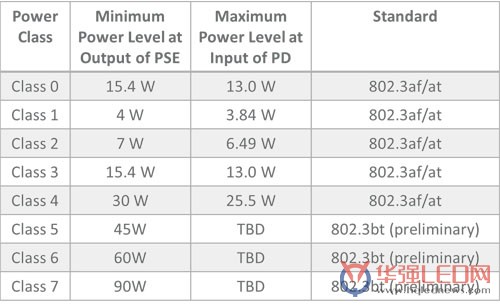LED lighting is now the mainstream technology and is gradually replacing incandescent, halogen and compact fluorescent lamps (CFLs) in commercial, industrial and residential sectors. The benefits of LEDs are well known, including longer life, higher energy efficiency, and very small lamp sizes. For example, LED lights can last up to 50,000 hours, while incandescent lamps typically last 1,000 to 2,000 hours, and CFLs have lifes of 5,000 to 10,000 hours. Due to the long service life, LEDs reduce operational/safety risks and labor costs due to the replacement of hard-to-reach lights. The cost of using LEDs is also much lower, and the brightness of 10W LEDs is about the same as that of 60W incandescent bulbs.
Although the benefits of using LED lighting are well known, the way in which they are powered efficiently is still controversial. This article describes how to use the modern Power over Ethernet (PoE) technology to provide DC power to LEDs. PoE technology is comparable to traditional AC lighting power supplies. However, if a local area network (LAN) is used to network the lights for additional benefits, the PoE technology is victorious and the maintenance cost of the LEDs is low.
DC power supply using PoE technology
The LED is essentially a low voltage DC device. To ensure compatibility with traditional AC power supplies, most LED drivers for illumination use AC/DC converters to convert AC power to a lower DC voltage. This conversion process reduces system efficiency, so designers have proposed a DC-based power system. Several studies have compared common AC systems with DC power systems. A study by the University of Carnegie Mellon University 2 found that using DC power saves $2,000 per year compared to using AC. If the LED is powered by a grid-connected solar PV power source, compared to using AC power. Using DC power saves $5,000 a year."
Now, based on the IEEE 802.3 standard, first released in 2003 and updated in 2009, you can use PoE technology to provide DC power to LED lights. The standard specifies that a single standard network cable (such as Cat5) can be used to directly power and communicate data to connected devices, and provide power through a power supply (PSE) on the switch/hub. The powered networking device (in this case, the LED lighting) is called a powered device (PD).
To account for network cable losses under worst-case operating conditions, the PSE provides a power supply that is higher than the power limit of the PD. The original PoE standard (IEEE 802.3af) stipulated that PSE power supplies use Cat3 or higher cable to provide a maximum of 15.4W in the 44VDC to 57VDC range. In this case, the PD is limited to 13.0W and the voltage range is 37VDC to 57VDC. Subsequent IEEE 802.3at standards increase power to 30W (PSE) with voltages ranging from 50VDC to 57VDC, using Cat5 or higher. At this time, the PD is limited to a maximum of 25.5W and the voltage range is 50VDC to 57VDC. The IEEE 802.3bt standard, which is expected to be approved soon, will further increase PoE power, with a minimum power of 90W for the PSE output port (Table 1).

Table 1: IEEE 802.3 power capacity, sorted by power class
When powered by PoE, each LED luminaire can be a standard RJ-45 connector plug-and-play device with its own independently addressable IP address. Not only that, but by adding sensors to LED luminaires, you can convert them from pure lighting devices to smart LED concentrators. With this configuration, each "smart" LED concentrator collects information about ambient light, temperature, humidity, and anonymity and returns it to the controller. For example, personnel detection ensures that lighting is turned on when someone enters the room and turns off when no one is in the room (Figure 1). Ambient light sensors also support daylight harvesting 5, as well as adjusting LED illumination to maintain constant brightness in the absence of daylight.

Figure 1: Networked lighting and sensor concentrators provide new features for areas that use lighting and turn off lighting when not needed
Multi Conductor Terminal Blocks
Multi Spring Terminal Block,4 Conductor Terminal Blocks,Spring Levels Terminal Blocks,Twin Terminal Blocks
Wonke Electric CO.,Ltd. , https://www.wkdq-electric.com